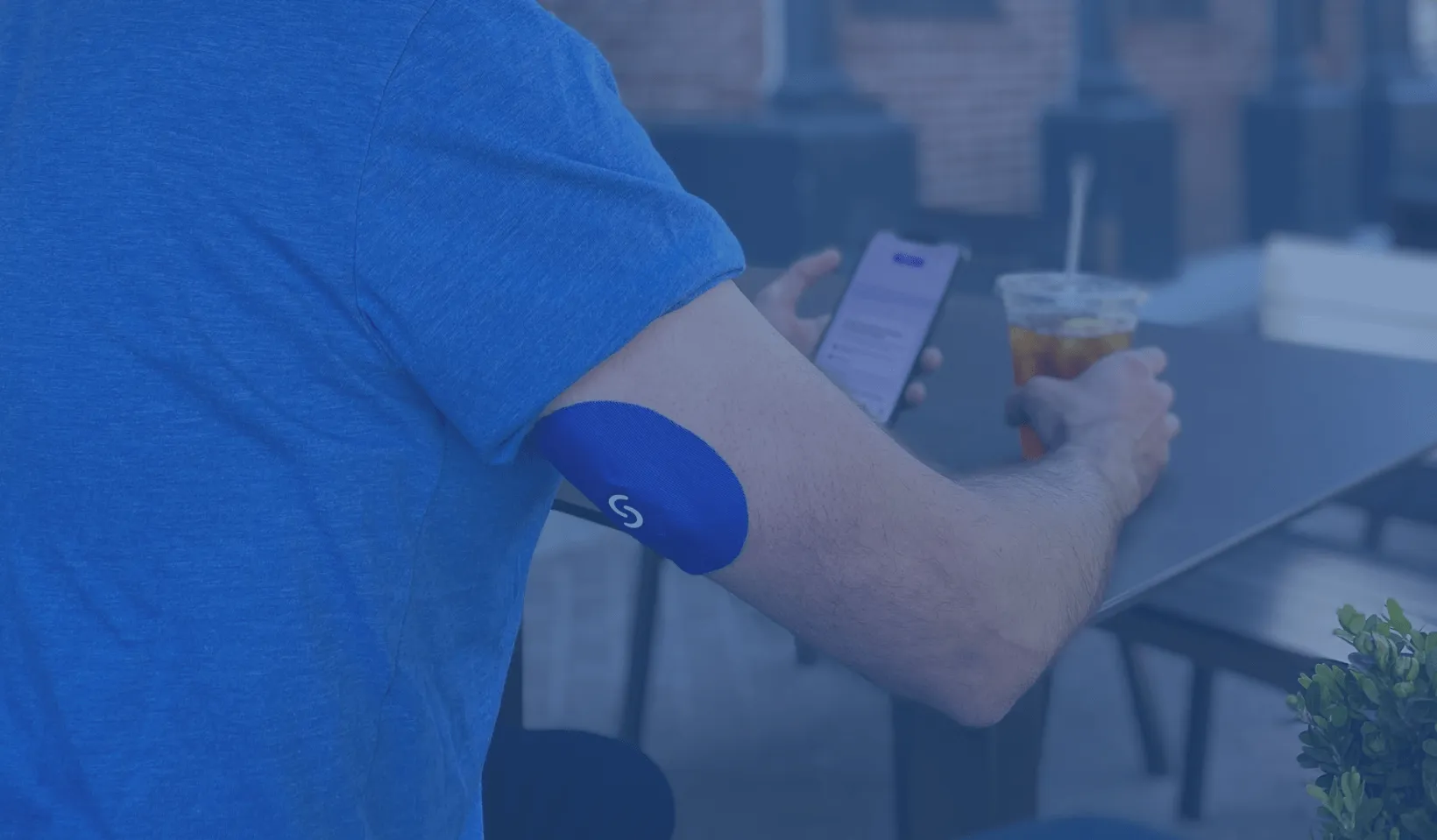Key Takeaways
- “Blood sugar” and “blood glucose” mean the same thing
- Carbohydrates, and sugars specifically, are what affects blood glucose the most
- When we can’t use all the carbs we consume, our body will try to store the extra glucose for future use as fat
- Maintaining a stable blood glucose level can help prevent weight gain
One of the trendiest and most-tweeted-about molecules in our bodies, glucose is a primary and preferred source of energy for the body. Also known as blood glucose or blood sugar, glucose refers to how much sugar circulates in your bloodstream.
{{mid-cta}}
What Is Glucose?
Glucose is a carbohydrate—a monosaccharide, to be exact—which means one (mono) sugar (saccharide). The suffix -ose is used in biochemistry to form the names of sugars, such as glucose, fructose (found in fruits), lactose (found in dairy), sucrose (table sugar).
Our bodies need glucose as a supply of energy. The brain, kidneys, liver, muscles, and even fat tissue use glucose to fuel their activities. Your body can make glucose via a process called gluconeogenesis and can even use the energy provided by ketones when glucose is scarce (such is the case during fasting or when severely restricting carbs); however, your body prefers to take the easier route (can you blame it?) and get glucose from what you consume.
Read more: Learn the details about glucose metabolism and the various fuel sources for your body
Our guide to glucose reveals all you need to know (and probably more) about glucose, what your fasting glucose and glucose levels can tell you about your metabolic health, and what steps you can take to monitor and control your glucose.
How Glucose Gets Distributed Through Your Body
When you eat, most carbohydrates, except for fiber, are broken down into glucose during digestion.
If you’re healthy, when glucose enters your body, it triggers insulin to be released from the pancreas in an amount that’s proportionate to the amount of glucose in the blood. Insulin directs transporter molecules to distribute glucose to your cells. Once in the cells, glucose gets broken down by the mitochondria to create ATP, the energy currency of your cells.
Some glucose gets used by the cells, some glucose can get used to power movement, and the rest of it enters your bloodstream, where it will first replenish any glycogen (a form of glucose) in your liver and muscles that are depleted. Any extra remaining glucose gets moved to stores in your adipose (fat) tissue.
While glucose is present almost everywhere in your body, we tend to measure it in the blood. Your concentration of blood glucose is measured in milligrams (mg) per deciliter (dL) of blood. Any guess as to how much glucose you might have in your blood?
Normally, we have about four grams of sugar in our bloodstream—about enough to fill a teaspoon.
Seems like a tiny amount, considering how much our bodies rely on glucose but that’s because glucose doesn’t circulate in the bloodstream for very long. A small amount stays in the blood and the rest gets sent to cells for use or to the liver and tissues for storage.
The body works hard to remain balanced, and that includes the amount of glucose in your blood. As yin and yang work to bring equilibrium to the universe, insulin works to remove glucose from your blood and glucagon puts glucose into the blood from storage.
What Are Glucose Levels and What’s a Normal Glucose Level?
For diabetics, the American Diabetes Association<sup>1</sup> (ADA) recommends the following blood glucose levels for adults:
- Between 80 and 130 milligrams per deciliter (mg/dL) before meals
- Less than 180 mg/dL two hours after meals
For non-diabetics adults, average normal glucose levels are:
- Fasting glucose: 70–90 (99 max) mg/dL
- Between 80–130 mg/dL before meals
- 1–2 hours after eating <140 mg/dL
Read more: What Are Average Glucose Ranges for Non-Diabetics?
Some people may have slightly higher blood glucose, including people who:
- Are 60 or older
- Have medical conditions, such as heart, lung, or kidney disease
- Have a reduced ability to sense low blood sugar levels
- Some pregnant women. During pregnancy, hormone levels change. This can make it harder for some to process blood sugar efficiently—these women can often develop gestational diabetes.
Blood glucose levels naturally change throughout the day in response to what you eat, how much physical activity you do, how much sleep you get, and a range of other factors. Keeping your glucose levels stable is important for maintaining a good energy level, mental sharpness, maintaining a healthy weight, and overall health.
Glucose Intolerance
People with chronically high glucose levels could be at risk for health issues related to glucose intolerance, such as:
Insulin resistance
Instead of being sensitive to insulin, your cells become resistant to it. When cells become insulin resistant, glucose stays in the bloodstream so the pancreas releases more insulin to deal with it. This cycle can lead to chronically high blood glucose.
Impaired fasting glucose
Fasting glucose values of 100–125 mg/dL when you first wake up and haven’t had anything to eat or drink may indicate impairment. If your fasting glucose is high regularly, this could be a sign of prediabetes.
Prediabetes
An intermediate stage between normal glucose and diabetes, prediabetes<sup>2</sup> can be diagnosed according to results of one of three tests: an A1C between 5.7–6.4%, fasting glucose between 100–125 mg/dL, or blood glucose between 140–199 mg/dL two hours after an oral glucose tolerance test.
Scroll to the next section for more details about the tests mentioned under the prediabetes category. If you do happen to have insulin resistance, impaired fasting glucose, or even prediabetes, know that it’s possible to reverse these conditions through lifestyle changes, possible pharmacological interventions<sup>3</sup>, and doctor supervision.
Some quick-reference definitions:
- Glucose levels and blood glucose levels: The amount of glucose in your blood, measured in mg/dL.
- Normal glucose levels: For non-diabetics, this ranges from 70–140 mg/dL and can be affected by what you do, what you eat and drink, how much you sleep, how stressed you are, etc.
- High glucose levels: For non-diabetics, anything over 140 mg/dL can be considered high. Your glucose can spike, or rise quickly, after eating certain foods, drinking sugary beverages, exercising at all-out or intense efforts, and sometimes when you’re super stressed out.
- Fasting glucose: The amount of glucose in your blood when you haven’t eaten or had anything to drink but water for eight hours. For non-diabetics, normal fasting glucose can fall in the range of 70–90 mg/dL.
How to Test Your Blood Glucose
Your blood glucose levels can be measured in several ways. If your doctor suspects you might have prediabetes or diabetes (or gestational diabetes for pregnant women), he or she will order tests, which can include:
- A1C test: Measures your average blood glucose over the past 2–3 months. An A1C below 5.7%* is normal, between 5.7–6.4% indicates prediabetes, and 6.5% and up points to diabetes.
- Oral glucose tolerance test (OGTT): Measures your blood glucose before and after you finish a glucose drink. You fast overnight (at least eight hours), have your fasted glucose tested, consume the drink, then have your glucose tested one and two hours after. At two hours, blood glucose of 140 mg/dL or lower is normal, 140–199 mg/dL indicates prediabetes, and 200 mg/dL or higher points to diabetes. Pregnant women take an OGTT to get screened for gestational diabetes.
- Fasting blood glucose test: Measures your blood glucose after an overnight fast (at least eight hours). Fasting glucose of 99 mg/dL or lower is normal, 100–125 mg/dL suggests prediabetes, and 126 mg/dL or higher indicates diabetes.
- Random blood glucose test: Measures your blood glucose at any time and does not require fasting. A reading of 200 mg/dL or above can indicate diabetes.
*Source for glucose test results: Centers for Disease Control<sup>4</sup>
A continuous glucose monitor (CGM) can also measure the glucose in your interstitial fluid and reveal your fasting glucose, results of an OGTT, and provide glucose readings every five minutes.
Small devices that are usually applied to your stomach or back of an arm, CGMs can reveal your unique glucose response to specific foods, portions of foods, exercise, stress, sleep, medication, and more. Recently, CGMs became available for use in non-diabetics and can be used as a tool to make healthful lifestyle changes that impact metabolism<sup>5</sup>, weight management<sup>6</sup>, and can help reverse prediabetes<sup>7</sup>.
8 Tips on How to Boost Glucose Control
How does blood glucose impact your health? It’s a metabolic health marker that we can control through everyday choices we make about foods, drinks, activity, sleep, and stress management.
Chronically high blood glucose over the long term can lead to insulin resistance, where the cells become resistant to insulin and must rely on additional amounts of insulin to get pushed into the cells. Insulin resistance has been connected to other health conditions, such as cardiovascular disease<sup>8</sup>, diabetes<sup>9</sup>, obesity<sup>10</sup>, and Alzheimer’s disease<sup>11</sup>.
To avoid these ailments and boost glucose control, research shows efficacy from the following:
1. Avoid excess sugar
Consuming lots of sugar will raise your blood sugar. Added sugars come in many forms, from raw lavender honey to brown rice syrup in Clif bars to corn syrup in apple butter, and these sugars are absorbed on top of other added or naturally-occurring sugars in the foods you eat with them. For example, spread 2 Tbsp. of apple butter on two slices of white toast, and you’re ingesting 25 grams of added sugar (64 grams total carbs) from fructose, corn syrup, high fructose corn syrup, and added sugar in the bread.
2. Avoid ultra-processed foods
Ulta processed foods can raise or spike your glucose, as these foods tend to be made with refined carbohydrates and added sugars. Examples include white bread, tortillas, crackers, corn chips, bagels, most cereals, flavored instant oatmeal, granola and snack bars, etc. One longitudinal study on children showed that ultra-processed food consumption in young children played a role in increasing abdominal obesity as they got older. Researchers suggest that the negative effect of ultra-processed foods on waist circumference in 8-year-olds may put them at risk for poor glucose metabolism<sup>12</sup> later in life.
3. Eat a real-food diet with an emphasis on low-glycemic carbohydrates
No matter what plan of eating you prefer, diet quality matters. Choose the most nutrient-dense foods you can afford and opt for real-food sources of low-glycemic carbohydrates (such as barley, quinoa, beans, legumes, lentils, vegetables, and low-GI fruits) the majority of the time. One scientific paper sums it nicely: “Dietary total antioxidant capacity, glycemic index, and glycemic load are potential markers of diet quality, which have an impact on the susceptible population with a cardiometabolic risk profile<sup>13</sup>.”
4. Kick the soda (even diet soda), fruit juice, and coffee milkshake habit
Sugar-sweetened beverages (SSB), including soda, fruit juice, and coffee drinks loaded with syrups and chocolate or caramel drizzles, spike blood glucose quickly—especially when consumed alone. Research shows that sugar-sweetened soda may promote insulin resistance<sup>14</sup> and is positively associated with prediabetes in middle-aged adults<sup>15</sup>. Liquid added sugars were a risk factor for the development of impaired glucose homeostasis and insulin resistance<sup>16</sup> in kids at risk of obesity, one study in over 600 kids found. Research on any possible association between diet soda consumption and impaired glucose metabolism is mixed, but the American Diabetes Association notes that drinking diet soda daily is associated with significantly greater risks of metabolic syndrome and type 2 diabetes<sup>17</sup> Best to avoid liquid sugar and sip sweetener- and sugar-free flavored sparkling water, coffee black or with a splash of cream or nut milk, and smoothies made with fiber-rich vegetables, fruits, and a wholesome protein source.
<p class="pro-tip"><strong>Learn more about </strong> <a href="/blog/diet-soda-blood-sugar-levels">diet soda's affect on blood sugar</a>.</p>
5. Exercise
Workouts, physical activity, walking, moving more outside of schedule exercise… all of these impact glucose metabolism. While type 2 diabetes most commonly develops from progressive insulin resistance via three pathways: oxidative stress that interferes with insulin signaling, inflammation that negatively affects insulin signaling and gene expression of glucose transporters, and accumulation of lipid intermediates in skeletal muscle that can impair insulin signaling. A review concludes that exercise can improve insulin sensitivity<sup>18</sup> by opposing the three previously mentioned forms of insulin resistance and allows muscles to use glucose (and its stored glucose, called glycogen) without the need for insulin to be released. The ability for muscle contraction to stimulate glucose uptake without insulin makes it powerful preventative medicine. Moving more often in short bouts of 5-minute microworkouts, 10-minute walk breaks, or 15 minutes of chores can help your muscles burn glucose throughout the day. For workouts, all exercise burns glucose, but you’ll reap the most glucose-impacting benefits from high-intensity intervals.
6. When you eat carbs, pair them with fiber, protein, some fat, or a combo
If you wear a CGM and track your glucose response to foods eaten in isolation, you’ll learn quickly that carb-rich foods eaten alone can increase your postprandial (after meal) glucose. To blunt the impact of the rise in glucose, pair the carb with fiber and a little fat. Or eat the carb with protein and you’ll likely see a less dramatic rise in glucose and may feel more satisfied for longer, too. For example, pair a sweet potato with cooked chicken and broccoli cooked in avocado oil. Eat a sliced apple with the skin dipped in unsweetened nut butter. Blend a peeled orange with a handful of berries, baby spinach, plain yogurt or coconut yogurt, hemp or flax seeds, and a scoop of no sugar added protein powder.
7. Manage sources of external stress
Psychological stressors raise glucose, and one study found a significant positive correlation between anxiety and glucose<sup>19</sup>. In another study, researchers analyzed data from 2,433 participants in the Netherlands Study of Depression and Anxiety and found a strong association of most metabolic syndrome components and anxiety<sup>20</sup>. The good news: Signos members have seen positive effects on glucose from deep breathing and meditation. Practice deep belly breathing, 4-7-8 breathing, progressive muscle relaxation, meditation, tai chi, gentle yoga, or guided imagery to reduce anxiety and stress.
8. Focus on sleep quality and getting enough shut-eye
Long-term effects of sleep disruption in healthy adults include weight-related issues, metabolic syndrome, type 2 diabetes<sup>21</sup>, and cardiovascular disease, according to one research review. A different review of scientific research showed an association between decreased self-reported sleep duration and an increased incidence of type 2 diabetes<sup>22</sup>, obesity, and cardiovascular disease, and that sleep disruption has detrimental effects on metabolic health. If you have trouble falling asleep, staying asleep, or not getting enough sleep, try to align your circadian rhythm with natural sunlight. Just like kids, adults need a wind-down period before bed. Stray from blue lights and do calming activities like reading a book or meditation or sipping herbal tea in a warm bath to relax. Make your sleep environment conducive to restful sleep—adjust the room temperature to be on the cool side (65 degrees is ideal), use darkening shades or a sleep mask, and turn on a white noise machine.
Continuous glucose monitoring can provide insight into what increases and spikes your glucose, and what doesn’t. It also reveals your fasting glucose, which is one of the key metrics to track for insulin resistance, prediabetes, and diabetes. Even for those who don’t have chronically high blood glucose, learning how your glucose reacts to different variables (food, exercise, stress, etc.) can alert you to make adjustments that can keep you metabolically healthy.
More Signos Articles About Glucose & Blood Sugar
Glucose & Blood Sugar FAQs
- What Is Glucose?
- What Is Glycemic Index and Glycemic Load?
- How Does A CGM Work?
- Why Should You Track Your Glucose?
- How to Mitigate High Glucose Spikes to Avoid Fat Storage
- What Is Impaired Fasting Glucose and Why Does it Matter for Your Health?
- Why Is Your Blood Sugar Higher in the Morning?
- What Should Your Blood Sugar Be at Bedtime?
- Can You Lower Blood Sugar by Drinking Water?
- Can Stress Cause High Blood Sugar?
Lowering & Stabilizing Your Blood Sugar
- How to Exercise to Lower Blood Sugar Quickly
- How To Naturally Lower Blood Sugar Fast
- Everyday Foods That Stabilize Blood Sugar Levels
- Stable Blood Sugar: How To Reap and Keep the Benefits
- The Relationship Between Alcohol and Your Blood Sugar
Low-Glycemic Diet
Topics discussed in this article:
References
- https://www.diabetes.org/healthy-living/medication-treatments/
- https://www.diabetes.org/a1c/diagnosis
- https://www.annualreviews.org/doi/abs/10.1146/
- https://www.cdc.gov/diabetes/basics/getting-tested.html
- https://europepmc.org/article/med/34628385
- https://diabetes.jmir.org/2020/4/e21551/
- https://journals.sagepub.com/doi/10.1177/1932296818790994
- https://academic.oup.com/jcem/article/86/2/713/
- https://diabetes.diabetesjournals.org/content/61/4/778
- https://www.ahajournals.org/doi/full/
- https://www.ncbi.nlm.nih.gov/pmc/articles/
- https://www.sciencedirect.com/science/article/
- https://www.mdpi.com/1422-0067/19/11/3662
- https://www.cambridge.org/core/journals/british-journal-of-nutrition/article/
- https://academic.oup.com/jn/article/146/
- https://academic.oup.com/jn/article/144/
- https://care.diabetesjournals.org/content/32/4/688
- https://europepmc.org/article/med/25034542
- https://www.sciencedirect.com/science/article/
- https://journals.lww.com/psychosomaticmedicine/Abstract/
- https://www.ncbi.nlm.nih.gov/pmc/articles/PMC5449130/
- https://www.ncbi.nlm.nih.gov/pmc/articles/PMC4370346/




.svg)










.svg)
.svg)
.svg)
.svg)
.svg)
.svg)
.svg)
